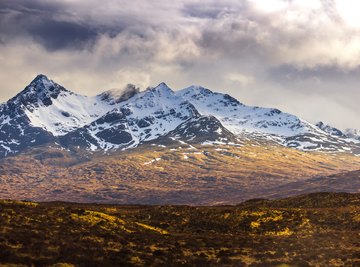
Earth's planetary climate depends on its relative position to the Sun. The Earth's surface can be divided into three climatic zones based on rainfall and temperature controlled by atmospheric convection currents.
The Köppen-Geiger climate classification system further subdivides the Earth's surface based on rainfall, temperature and seasonal patterns.
Earth: The Habitable Planet
Earth's global climate consists of the averages of all the regional climates. The global climate depends on the energy received from the Sun and how much energy stays trapped in the planetary system. These factors change from planet to planet. The factors that make Earth tolerable for life (as we know life) start, like all good real estate, with location, location, location.
The Earth revolves around the Sun at a distance that keeps the overall temperature comfortable. In addition, the Earth sits at a distance that reduces the Sun's destructive radiation to a tolerable level.
The Earth consists of a rocky ball rather than a gaseous sphere. The Earth has a molten outer and solid inner iron-nickel core, however, which spins and generates a magnetic field.
The magnetic field helps deflect bursts of deadly solar radiation. The core also helps provide a source of geothermal heat to the mantle and, eventually, to the crust. The Earth also has an atmosphere. The current nitrogen-oxygen-argon atmosphere contains enough carbon dioxide and water vapor to trap the Sun's heat energy while also providing protection from radiation.
Earth's Major Climatic Zones
The Earth's surface can be divided into three major regional zones based on the three global convection cells that control average rainfall and average temperatures. The edges of the zones fall roughly along lines of latitude. The three zones are the tropical zone, the temperate zone and the polar zone. These zones have been subdivided using the Köppen-Geiger climate classification system.
Two Köppen-Geiger climate zones that occur across the three major regional zones are the Dry Zone and the Polar-Highland Subclimate. The Dry Zone is subdivided into the Desert Subclimate where average annual rainfall is less than 10 inches per year and the Semiarid Subclimate where rainfall averages slightly over 10 inches of rain per year.
In the Dry Zone, evaporation exceeds precipitation. The Dry Zone designation does not depend on temperature.
The Polar-Highland Subclimate has widely variable temperatures, depending on elevation, latitude and orientation. Elevation controls the climatic conditions in the Polar-Highland Subclimate. Mountains scattered around the world have Polar-Highland Subclimate conditions in their upper elevations.
Characteristics of the Tropical Zone
The tropical zone lies approximately between 25° north and 25° south latitudes. The tropical zone receives direct sunlight year-round, so the average temperature stays greater than 64°F (18°C) and the annual precipitation is greater than 59 inches. In the Köppen-Geiger climate classification system, the tropical zone is named the Humid Tropical Zone.
Read more about characteristics of humid tropical climate.
This zone has been subdivided into two subclimates, the Tropical Wet and the Tropical Wet & Dry. As the name indicates, the Tropical Wet Subclimate is hot and rainy all year. Tropical rain forests grow in this subclimate. The Tropical Wet & Dry Subclimate has distinct rainy and dry seasons.
Characteristics of the Temperate Zone
Characteristics of temperate climates are moderate temperatures and rain year-round. The local climates in the temperate zone show greater variability than the tropical zone, however. The temperate zone lies roughly between 25° and 60° north and south latitudes. At this point in geologic time, most of the Earth's land masses lie in the temperate zone.
In the Köppen-Geiger climate classification system, the temperate zone is divided into two zones: the Moist-mid Latitude - Mild Winters Zone and the Moist-mid Latitude - Severe Winters Zone. The Moist-mid Latitude - Mild Winters Zone is subdivided into three subclimates: Humid Subtropical, Marine West Coast and Mediterranean.
As the name implies, these temperate areas share the characteristic of relatively mild weather, even in winter. The Moist-mid Latitude - Severe Winters Zone is subdivided into two subclimates: Humid Continental and Subarctic. Both subclimates experience cold snowy winters. The Humid Continental Subclimate has hot, humid summers while the Subarctic Subclimate endures short summers and long winters.
Characteristics of the Polar Zones
The polar zones extend from 60°N and 60°S latitudes to the north and south poles, respectively. In general, the variability of sunlight controls the climate characteristics of polar zones because each pole spends part of the year with no sunlight.
Read more for information about the polar zone.
Even during each pole's summer, the sunlight hits at an angle that greatly reduces the heat energy. The annual temperatures for the polar zones almost always average below freezing with even the warmest month averaging below 50°F (10°C).
In the Köppen-Geiger climate classification system, the Polar Zone is subdivided into three Subclimates: Tundra, Icecap and Highland. The Tundra Subclimate typically is cold and dry with short cold summers. The Icecap Subclimate fits its name with freezing temperatures all year. The Highland Subclimate, as previously discussed, occurs at higher elevations around the world.
References
- University of Utah: Conditions that Support Life
- UCAR Center for Science Education: Climate
- National Oceanic and Atmospheric Administration: Changing Seasons
- National Weather Service: Climate Zones
- California State University (Northridge): Climate Zones
- Tulane University: The Ocean-Atmosphere System
- Encyclopaedia Britannica: Highland Climate
Resources
About the Author
Karen earned her Bachelor of Science in geology. She worked as a geologist for ten years before returning to school to earn her multiple subject teaching credential. Karen taught middle school science for over two decades, earning her Master of Arts in Science Education (emphasis in 5-12 geosciences) along the way. Karen now designs and teaches science and STEAM classes.
